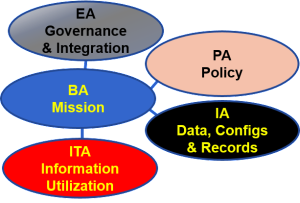Mission is the way vision, purpose and objective are pre-established and imposed.
Mission Capability
The mission capability is the business capability system which functions to realize goals/strategic actions, incentives, principals, socio-technical influence, socio-cultural influence and other stimulatory resources used to influence, enable and assure the mission.
The purpose of the mission capability is to enable and assure the abilities of the strategic resources used to influence, enable and assure the mission of the enterprise.
Mission Management
Mission management is the business capability management of the mission capability.
The purpose of mission management is to enable and assure the management and abilities of the mission capabilities of the enterprise are controlled, balanced and aligned to the mission and needs of the enterprise as a whole.
Mission Management Responsibilities
The business manager role is responsible for mission management of the mission capability.
Mission management work products include mission management ideas, requirements, plans, risks, opportunities, reviews, decisions and action items. Specific examples are strategic requirements, long-term plan, short-term plan, strategic plan, risk and opportunity management plan, and risk and opportunity management database.
Mission Architecture
The mission architecture is the business architecture of mission management of the mission capability.
The business manager role uses the mission architecture to support mission management responsibilities and activities.
The purpose of the mission architecture is to provide a management structure to enable and assure the mission capability of the enterprise is controlled, balanced and aligned to the mission and needs of the enterprise as a whole.
The structure includes mission, principals, goals, strategic actions and incentives.
Mission Architecture Responsibilities
The business architect role is responsible for architecting the mission architecture in support of the mission management responsibilities of the business manager role.
Mission architecture work products include mission architecture concepts, descriptions, models, views, viewpoints, specifications and analyses. Specific examples include a transformation roadmap, balanced scorecard, risk and opportunity identifications and SWOT analysis.
Mission Team
As shown in Figure 2 – Mission Team Concept, mission is interconnected with and interdependent on governance, integration, policy, data, configurations, records and information utilization.
 Figure 47 – Mission Team Concept
Figure 47 – Mission Team Concept
Within the business capability mission is interconnected with and interdependent on markets, portfolio, talent, operations and business management.